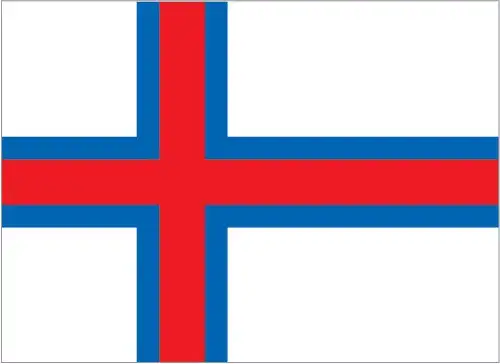Faroe Islands Flag
National Flag of Faroe Islands
Faroe Islands Flag Display

Quick Facts About Faroe Islands and Faroe Islands Flag
- Adopted:
- Aspect Ratio:
- 8:11
- Capital:
- Tórshavn
- Population:
- Approximately 50,000 (2023)
Flag Description
The national flag of the Faroe Islands is known as *Merkið*, meaning 'the banner' or 'the mark'. It features a red Nordic cross outlined in blue on a white field. The cross is shifted toward the hoist in classic Scandinavian fashion, reflecting the islands’ deep cultural and historical ties with other Nordic nations.
Symbolism & Meaning of the Faroe Islands Flag
White symbolizes the clear skies and the foamy waves of the North Atlantic Ocean that surround the islands. The red color represents the blood, vitality, and Christian heritage of the Faroese people, while the blue highlights the sea, as well as the historical connection to Norway and Iceland, both of which use similar cross designs in their own flags.
Historical Background of the Faroe Islands Flag
The flag was first conceived in 1919 by Faroese students studying in Copenhagen, notably Jens Oliver Lisberg, who brought the idea home. It was first raised on 22 June 1919 in the village of Fámjin. Although initially unofficial, the flag gained recognition during World War II when the United Kingdom, which was protecting the islands after Denmark was occupied by Nazi Germany, authorized its use on Faroese vessels to distinguish them from Danish ships. After the war, the flag was officially recognized by Denmark in 1948 with the establishment of Faroese home rule, and it became a symbol of national identity and autonomy.
Design Elements of the Faroe Islands Flag
The flag consists of a white field with an off-center red cross, outlined in blue. This configuration follows the traditional layout of Nordic cross flags. The cross’s vertical part is closer to the hoist side. The specific design follows a proportional structure of 6:1:2:1:12 horizontally and 6:1:2:1:6 vertically. The official colors are white, red (Pantone 032), and blue (Pantone 300). The flag’s shape follows an 8:11 ratio, slightly different from the more typical 2:3.
Usage & Protocol of the Faroe Islands Flag
Flag usage is governed by Faroese flag law, which outlines correct handling and ceremonial practices. The flag is typically raised at sunrise and lowered at sunset. It must never touch the ground or be flown in a damaged state. On official buildings, the Merkið takes precedence over other flags, except in diplomatic contexts. The flag may be displayed beside the Danish national flag, but never on the same pole. The national Flag Day is celebrated on 25 April to commemorate the day of maritime recognition during WWII, and is observed with public ceremonies, parades, and cultural events.
Frequently Asked Questions
What do the colors of the Faroe Islands Flag represent?
White symbolizes the clear skies and the foamy waves of the North Atlantic Ocean that surround the islands. The red color represents the blood, vitality, and Christian heritage of the Faroese people, while the blue highlights the sea, as well as the historical connection to Norway and Iceland, both of which use similar cross designs in their own flags.
When was the Faroe Islands Flag adopted?
The Faroe Islands flag was adopted on 25 April 1940 (at sea), 23 March 1948 (on land), marking an important milestone in the country's development as an independent nation.
What is the aspect ratio of the Faroe Islands Flag?
The Faroe Islands flag has an aspect ratio of 8:11, which determines the proportional relationship between its width and height for official display purposes.